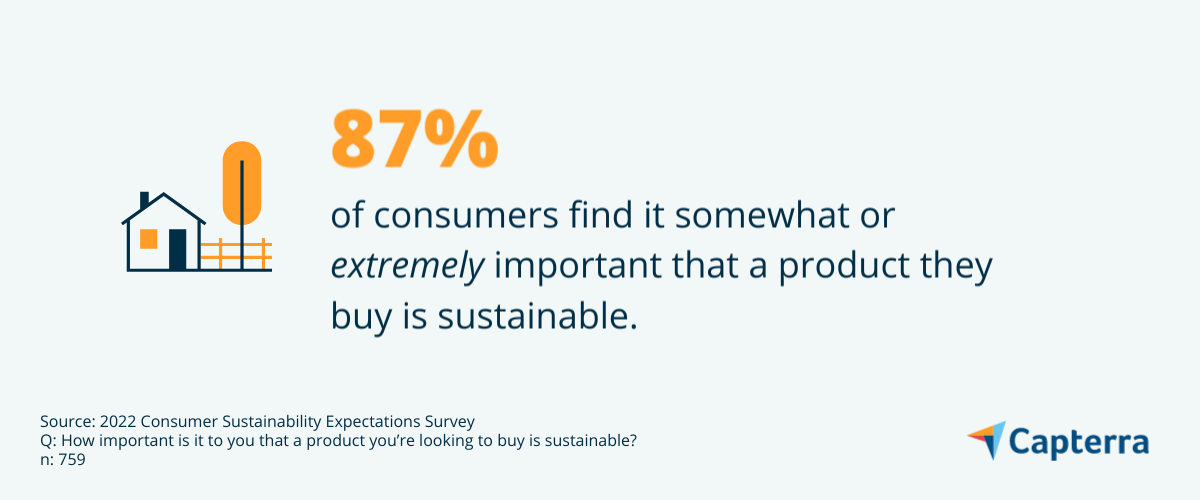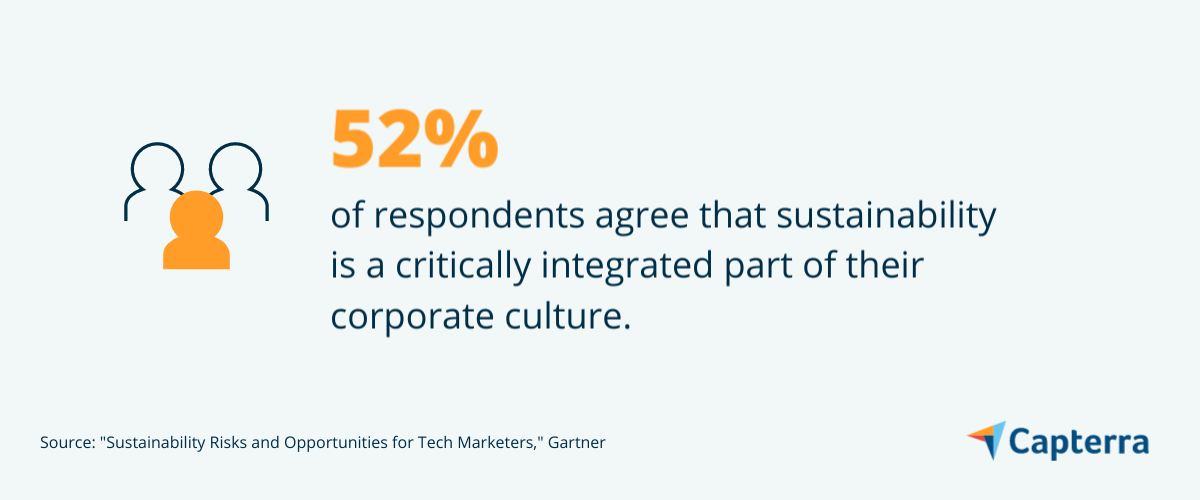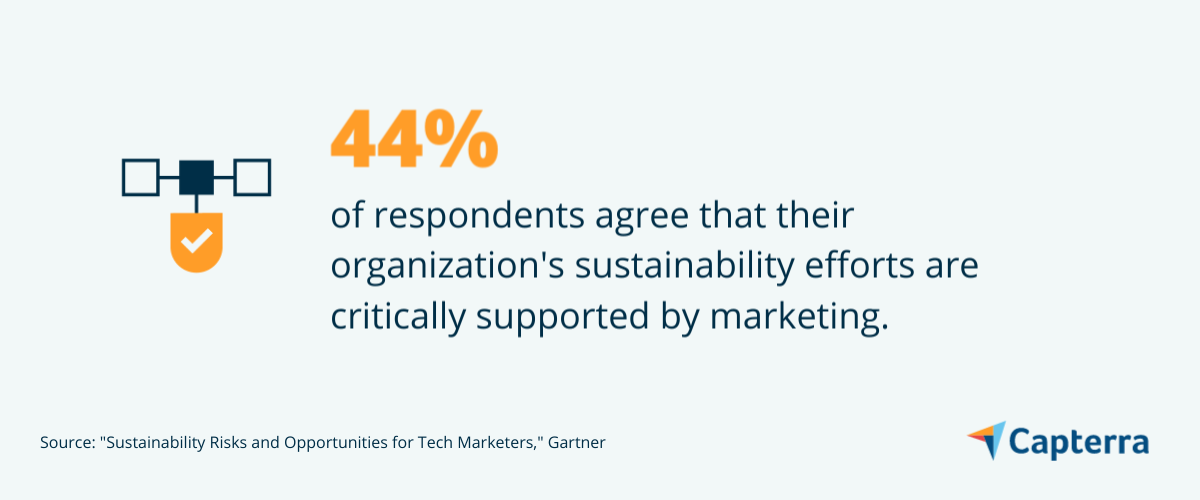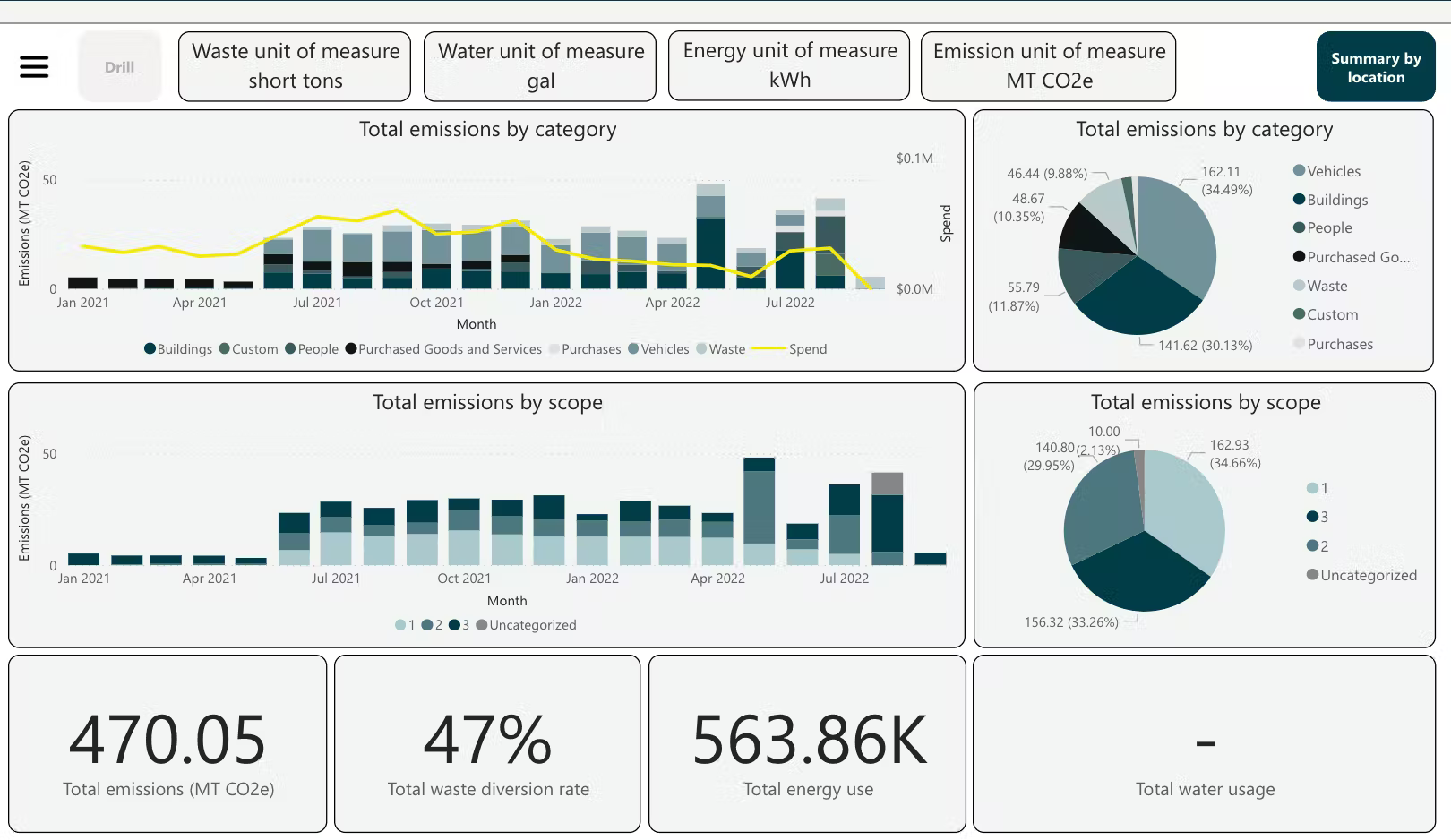Build a more sustainable future for your small business with these key findings.
The concept of sustainability is seemingly everywhere these days. Consequently, sustainable practices—and consumer expectations around them—have been guiding business decisions more and more. In fact, according to Capterra’s 2022 Consumer Sustainability Expectations Survey*, 55% of consumers mostly or always check if a product is sustainable.
If you’re a marketing manager or leader trying to determine if sustainable marketing tactics are worth pursuing for your marketing strategy, we’re here to guide you. Below you’ll discover three findings from Gartner research and survey data that will help you understand marketing’s role in sustainability.
You may be surprised to learn that role is critical and that expectations around sustainability aren’t just coming from customers. If you’re ready to dive in, read on for more. But first, let’s define what sustainable marketing is.
What is sustainable marketing?
Sustainable marketing, sometimes referred to as green marketing, is a form of innovative marketing that involves a business’ use and promotion of environmentally friendly sustainability practices. This can include how a sustainable brand promotes their products, services, and brand values. Typically, the marketing aspect is represented by a business’ efforts to communicate these values to customers, investors, and stakeholders.
Greenwashing, however, is when a company purports to value sustainability but isn’t actually making any notable sustainability efforts[1]. This behavior is often done in an effort to gain approval from conscious consumers and environmental advocates using sustainable marketing practices without incurring the cost or effort involved in meaningfully exercising them.
Finding #1: Sustainability affects purchase decisions for the vast majority of consumers
Our first finding has to do with consumer expectations around sustainability, and it turns out that they are high. In fact, according to Capterra’s 2022 Consumer Sustainability Expectations Survey*, 87% of consumers find it somewhat or extremely important that a product they buy is sustainable.

This represents a huge majority of consumers and is something that any business who produces products for the mass market should not only be aware of but act on, as well. One way businesses can accomplish this is through effective brand storytelling.
Brand storytelling uses narrative techniques to connect a brand with customers on a deeper level than traditional marketing can achieve. This tactic generally focuses on supporting a brand’s values and/or creating an emotional connection with the audience through authentic content that can be shared on a variety of marketing channels.
One brand that’s taken furthering their values to the next level through brand storytelling is Warby Parker. With their Buy a Pair, Give a Pair initiative[2], Warby Parker donates glasses and eye care services to those in need in 50 countries around the world.

A screenshot from Warby Parker’s Buy a Pair, Give a Pair webpage [2]
This massive network of local service providers bolstered by Warby Parker’s manufacturing and distribution system not only provides eye care for underserved populations, it also promotes sustainability by centralizing key elements of their go-to-market strategy and supporting local businesses who provide those eye care services.
You may be asking how this applies to your small business. Well, according to Gartner’s 2021 Win With Narrative Design report[3], effective narratives are now becoming essential to driving engagement. If your business finds itself in a growth stage characterized by a need for more awareness and engagement, promoting your brand’s values through storytelling is precisely the way to do it.
Finding #2: Businesses are facing increasing pressure to demonstrate a commitment to sustainability
In our next finding, Gartner indicates that nearly a third (30%) of businesses face pressure from investors, customers, influencers, and staff to demonstrate a commitment to sustainable practices[1].
This percentage will continue to increase as social norms around consumer and corporate responsibility develop, and now is the time to begin ingraining these values within your own organization. The writing’s on the wall: It’s not just consumers who care about sustainability—it’s, well, everyone.
Businesses have already started taking note of this as well, with 52% of those surveyed agree that sustainability is a critically integrated part of their corporate culture.

What does this mean for your small business? And more specifically, what does it mean for your marketing efforts? We’ll get to the latter below, but for starters you should be considering how every part of your organization affects your sustainability bottom line and whether there are changes you can make to move the needle in a more responsible direction.
This includes aspects such as:
Where do you source materials for your products and services?
Who do you conduct business with if you partner with third-party suppliers or service providers? What are their views on sustainability?
If you sell products, how are they distributed?
Do you partner with local purveyors when possible?
If you have a brick-and-mortar location, what is its carbon footprint like?
All of these are good questions to ask as you explore the topic of sustainability, and they are all important to answer if you’re serious about genuinely promoting it as a business. Now, as promised, we’ll see where marketing fits into the bigger picture.
Finding #3: Marketing is a critical part of an organization’s sustainability efforts
Marketing has a bigger role in a business’ overall sustainability picture than you might think. In fact, according to Gartner research, an organization’s sustainability efforts are critically supported by marketing for 44% of respondents[].

Why is this? The main reason is that sustainability efforts must be communicated for them to have a positive effect on perceptions of your brand. Needless to say, supporting sustainable practices should be a focus whether or not you get brownie points for it.
However, the fact remains that being meaningfully sustainable as a business and communicating it effectively are what will attract new sustainability-minded customers, impress the ones you have, and further strengthen your brand’s image as a responsible and empathetic organization.
According to Gartner, this type of storytelling helps create micronarratives within your brand story that act as meaningful touch points along the customer journey[3].
/ Micronarrative definition
Contextually specific messaging that addresses detailed needs for a pivotal moment in the customer experience, usually specific to a customer persona.
In this case, an example of contextually specific messaging may be that your product is made from 100% recycled materials. The pivotal moment comes when your customer is deciding whether to purchase your product vs. a competitor’s. And the persona you’re speaking to is a consumer that values sustainability.
Components of effective sustainable marketing
Below you’ll find info on the basic components of successful sustainable marketing. Keeping these in mind as you assess and develop your own sustainable marketing campaign will ensure that you’re serving the greater purpose of reducing your environmental impact effectively.
Determine your larger purpose
As mentioned earlier, you run the risk of committing greenwashing if you simply pretend to be sustainable for good optics or increased sales. Take the time to sit down with leaders in your organization to determine what it is you’re really trying to accomplish with sustainability initiatives:
Are you trying to reduce your carbon footprint to make an impact on the environment?
Is your goal to help an underserved community?
Do you want to improve the way products and services in your industry are made and distributed?
Asking yourself questions like these will help determine an overarching goal to strive for which will then guide the tactics you use to get there. Uniting around a singular mission also strengthens your messaging and gives people within your organization something to rally around.
Remain customer focused
Remember that 87% of customers find it somewhat or extremely important that a product they buy is sustainable. Taking meaningful steps to heed this finding will not only help you attract new customers, but it will also help retain the ones you have.
Once you’ve determined what steps you’ll take to improve your business’ sustainability, find ways to share these values with your customers at opportune times. Some example of this include:
A landing page on your website dedicated to sustainability.
Badges that represent corporate sustainability initiatives or certifications on your website.
Messaging within your mission statement or values that directly speak to sustainability.
Content marketing pieces (social, email, etc.) that share your views on the subject and steps you’re taking to be a responsible business.
Reminders of the impact your products have on the environment at the point of sale.
Think long term
Sustainability is about the long term, not just posting online and calling it a day. Make an effort to plan how your short term actions will carry into the future as you plan and execute on new initiatives.
How will your program improve over time?
How will you measure success?
What measures can you take a year or more down the line to continue increasing your efforts?
Thinking about these things early will help you develop a plan for continuing to act sustainably as your business scales. You may also be presented with new opportunities that you’ve already accounted for by thinking ahead, allowing you to act on them smarter and faster.
Strive for consistency
Messaging is all about consistency, and the same goes doubly so for corporate responsibility and sustainability. Frankly, customers can detect it a mile away when businesses do something simply to garner praise, so be authentic and consistent in your message from the very beginning.
This means keeping your website updated, refreshing corporate responsibility content regularly, finding ways to support partners that contribute to your initiatives, and highlighting ways in which your company is meaningfully promoting sustainability.
Ways to build a more sustainable future for your small business
Now that you’ve been presented with compelling reasons to increase sustainability at your organization and an overview of the components required, what about some tools to help you get there? Below we’ll briefly cover the technology, partnerships, and internal actions you can take to build a more sustainable future for your small business.
Sustainability software
Sustainability software helps organizations manage their impact on the environment, promote social responsibility, and comply with government regulations on emissions, renewable resources, and recycling.

An example of an environmental impact dashboard from Emissions Management (Source)
The insights generated by these types of tools make companies better equipped to not only comply with government regulations but also become responsible organizations through environmentally friendly actions.
For more information on the benefits of sustainability software, typical features, cost, and more, check out our Capterra Buyers Guide for Sustainability Software.
Service providers who value sustainability
If you partner with a third party service provider, it’s important that their values align with yours. And this goes for issues beyond sustainability, as well.
Aside from other, more basic factors such as size, expertise, location, and cost, partnering with a service provider that takes your mission and values to heart can be a huge boon to your efforts—both on and off the balance sheet.
During the service provider search process, vet potential providers to ensure they align with both your business goals and values, especially those with important and far-reaching implications like working culture, diversity and inclusion, and sustainability.
For more info on the search provider search process, visit our article 4 Key Considerations to Help You Choose a Digital Marketing Agency.
Company culture
One of the most impactful areas to promote sustainability coincidentally also costs the least. And that is, of course, the culture of your business. If you value sustainability, find ways to highlight it within your own organization and share it with your people.
These ways can be both big and small, including everything from incentivizing recycling and sustainable practices amongst employees to creating company-supported initiatives or updating office spaces to be more environmentally friendly.
This type of action will not only indicate that you’re serious about the issue, but it will also spur people to act on their own from the example that’s been set. Ultimately, making meaningful changes as a company and leading by example is the most effective and long lasting way to promote sustainability.
Ready to learn more about marketing your small business?
While we’ve covered a lot of ground today on sustainable marketing principles, there’s still a lot to learn when it comes to marketing a small to midsize business. If you’re ready to dive into more information so you can continue gaining an edge in your industry, make sure to keep your eyes on the Capterra blog, starting with these resources:
3 of The Latest Trends in Marketing Analytics to Look Out For
Online Marketing for Small Business: Strategy Tips From Successful SMBs
Note: The applications selected in this article are examples to show a feature in context and are not intended as endorsements or recommendations. They have been obtained from sources believed to be reliable at the time of publication.
